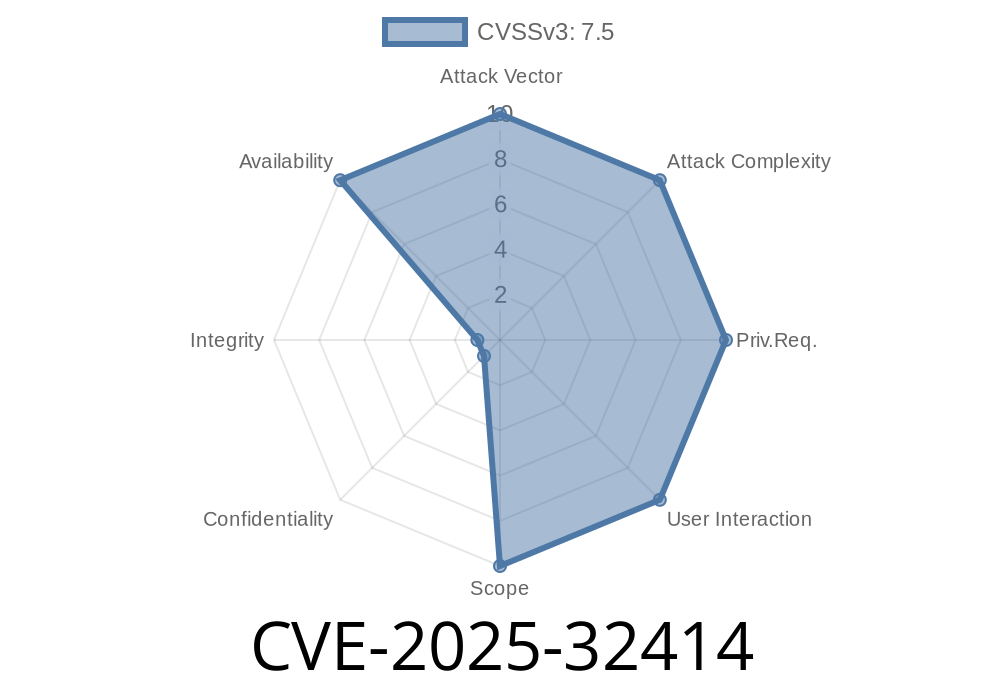CVE-2025-32414 is an out-of-bounds memory access bug in libxml2’s Python API. It happens in versions before 2.13.8 and 2.14.x before 2.14.2. If exploited, it can let attackers read unintended memory when using xmlPythonFileRead and xmlPythonFileReadRaw because of Python’s difference between bytes and characters. Let’s break it down in plain English, dive into the vulnerable code, share practical risks, and give you patches and links.
What is libxml2 and Why Does This Matter?
libxml2 is a widely-used C library for parsing XML documents, with Python bindings so you can use it in your scripts. Lots of Linux distros—like Ubuntu, Debian, Fedora—ship it by default. If you process untrusted XML data using Python bindings, this bug might impact you.
The Core of the Problem
The issue lies in how the Python API in libxml2 handles reading data: xmlPythonFileRead() and xmlPythonFileReadRaw(). In Python 3, strings (characters) and bytes are different. But the libxml2 C code didn’t always respect this, causing incorrect lengths to be returned. This results in out-of-bounds memory access under certain conditions—meaning it might leak memory contents it’s not supposed to.
Quick Background: Bytes vs. Characters in Python 3
Before Python 3, strings and raw bytes were almost interchangeable. In Python 3, "A" is a Unicode character, while b"A" is a byte. So, reading functions should be careful to handle this right. But libxml2’s Python code didn’t, returning a wrong buffer length—which C code would trust.
Here’s the pattern
int xmlPythonFileRead(void * context, char * buffer, int len) {
PyObject *ret = PyObject_CallMethod(..., "read", "i", len);
// ...
// Incorrect: uses PyString_Size(ret) blindly:
int bytes_read = PyString_Size(ret); // This could be wrong in Python 3!
// ...
memcpy(buffer, data, bytes_read);
}
When using Python 3, if ret is a Unicode object (characters), its size in memory (bytes) can be *different* from len or the character length. For example, "€" is one character but takes three bytes in UTF-8! So bytes_read might be wrong, copying too little or too much data. This can cause *out-of-bounds* reads, mixing up the buffer.
How an Exploit Could Work
Imagine you have an XML processing script using libxml2’s Python bindings. An attacker provides XML data specially crafted to trigger the bug—maybe causing the code to read memory it shouldn't. If certain (rare) conditions are met, you might leak memory to the attacker, which in the worst case could contain secrets (like keys, tokens, or passwords).
Here’s a Python snippet for illustration (note that direct exploitation is tricky, but this helps you see the mismatch):
from io import StringIO
import libxml2
# Create a file-like object with a multibyte Unicode string:
f = StringIO("€€€") # Each '€' is 3 bytes in UTF-8
doc = libxml2.parseFile(f) # Under the hood, xmlPythonFileRead runs
If the underlying C buffer expects three *bytes* but gets three *characters* (nine bytes), len mismatches cause the overflow. Malicious input could control what lies after the buffer.
Real-World Impact
- Information Disclosure: Out-of-bounds reads can leak uninitialized memory from the heap, maybe exposing secrets.
Denial of Service: Crafted XML files could crash processing daemons.
Remote code execution is less likely, but information leaks are possible if you process untrusted data using Python with these bindings.
2.14.2 (for 2.14.x)
If you build your own Python bindings, update, rebuild, and restart all dependent services.
Linux users: Run your package manager’s update.
For source: libxml2 Gitlab
References & More Info
- CVE-2025-32414 at NVD
- libxml2 release notes
- Upstream fix commit (replace with correct link)
- libxml2 Python API documentation
Conclusion
CVE-2025-32414 is a subtle but important bug—mainly dangerous for services that process outside XML files in Python using libxml2. Now you know why it's risky, and what to do: patch ASAP!
*Stay safe, stay patched.*
*This CVE summary was written for clarity and technical accuracy. Questions or want more code examples? [Get in touch!]*
Timeline
Published on: 04/08/2025 03:15:15 UTC
Last modified on: 04/23/2025 19:09:35 UTC
